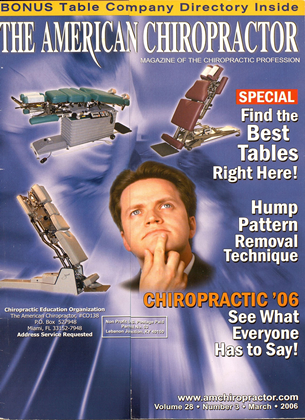Reference: Cervicogenic Headache: A Review of Diagnostic and Treatment Strategies Journal of the American Osteopathic Association April 2005, Vol. 105, No. 4 Supplement, pp. 16-22 David M. Biondi, D.O. Key Points from Dan Murphy: "Ccrvicogcnic headache is a relatively common cause of chronic headache that is often misdiagnosed or unrec ognized." Cervicogenic headache is chronic hemicranial pain that is referred to the head from tissues of the neck. Head pain that is referred from the tis sues of the neck is called cervicogenic headache. Cervicogenic headache was not of ficially recognized until 1983. The key neurological structure in cervicogenic headache is the trigemi- nocervical nucleus. The trigeminocer- vical nucleus is a region in the upper cervical spinal cord where sensory nerve fibers from the trigeminal nerve (cranial V) interact with sensory fibers from the upper cervical nerve roots. The convergence of upper cervical and trigeminal sensory fibers is the basis for upper cervical problems causing pain in the face and head. Cervicogenic headache is often a sequela of head or neck injury, but may occur in the absence of trauma. (Important] The prevalence of cervicogenic head ache is as high as 20% of patients with chronic headache. Cervicogenie headache is four times more prevalent in women. "'Patients with cervicogenic headache will often have altered neck posture or restricted cervical range of motion." Cervicogenic headache pain can be "triggered or reproduced by active neck movement, passive neck posi tioning, especially in extension or ex- tension with rotation toward the side of pain, or on applying digital pressure to the involved facet regions or over the ipsilateral greater occipital nerve." 12. X-ray, magnetic resonance imaging (MRI), and computed tomography (CT) are non-diagnostic in cervico-genic headache patients. l3.Zygapophyscal joint, cervical nerve, or medial branch blockade is used to confirm the diagnosis of ccrvicogenic headache. Trauma to or pathologic changes to the C1-C2-C3 joints can cause head pain. The third occipital nerve (dorsal ramus C3) innervates the C2-C3 facet joint. The C2-C3 facet joint and the third oc cipital nerve arc the most vulnerable to trauma from acceleration-deceleration whiplash injuries of the neck. [Impor tant] It can take a year or longer for post- whiplash cervicogenic headache to resolve. Disc problems as low as C5-C6 can cause chronic ccrvicogenic head ache. The treatment of cervicogenic head ache usually requires manipulation of the upper cervical facet joints. | Impor tant] 19) Drugs alone are often ineffective for cervicogenic headache treatment. 20. "Many patients with cervicogenic headache overuse or become dependent on analgesics." 21.COX-2 inhibitors [Celebrex] cause both gastrointestinal and renal toxicity after long-term use. COX-2 inhibitors [Celebrex] cause an increased risk of cardiovascular and cerebrovascular events. "All patients with cervicogenic head ache could benefit from manual modes of therapy and physical condition ing." Manipulative techniques are particu larly well suited for the management of cervicogenic headache, including high velocity, low amplitude manipu lation. Based upon this article, I have created the following form to assist in the diagnosis of ccrvicogenic headache, (see table in next column) A 1978 graduate of Western States Chiropractic College, Dr. Dan Murphy is on the faculty of Life Chiropractic College West, and is the Vice President of the International Chiropractic Association. For more information, visit www.danmurphYdc.com.fJEM Diagnostic Criteria for Cervicogenic Headache (Developed by the Cervicogenic Headache International Study Group) The patient must have at least one of the following: 1. The head pain must be preceded by: □ Neck movement or a Sustained awkward head positioning D External pressure over the upper cervical (C1-2-3-4) or occipital region on the symptomatic side 2. d Restricted cervical spine range of mo- tion (active and passive) 3.n Ipsilateral neck, shoulder, or arm pain of a vague nonradicular nature or □ Occasional arm pain of a radicular nature If all three criteria are present, one is essentially assured of cervicogenic headache. Characteristics of Cervicogenic Headache □ Frequently, a history of indirect neck trauma [whiplash injury] d Unilateral headache that does not change sides □ Occasionally, the pain may be bilateral a The pain is located occipital, frontal, temporal, or orbital regions a The pain can last hours to days □ The headache usually begins in the neck nThe headache is moderate to severe DThe headache is non-throbbing nThe headache is non-lancinating The following features may also be occasionally noted: □ Nausea a Phonophobia d Photophobia d Dizziness . .: " □ Difficulty swallowing n Ipsilateral blurred vision Vomiting Ipsilateral lacrimation ■ Ipsilateral edema, especially in the peri- ocular region
 View Full Issue
View Full Issue






